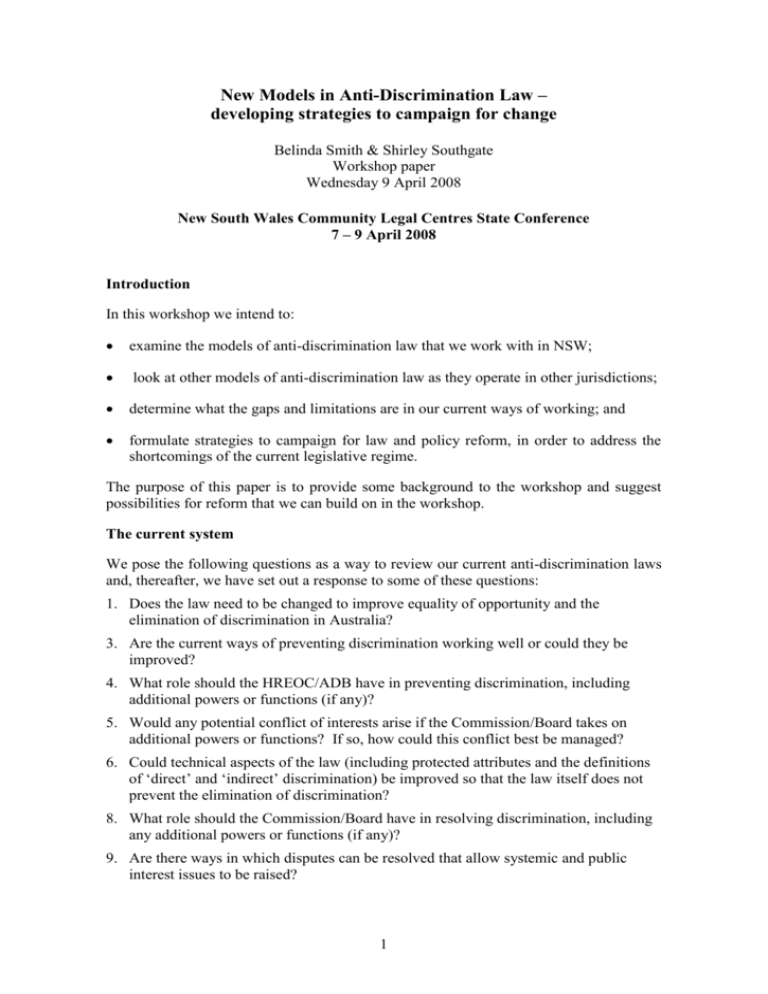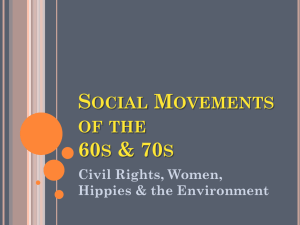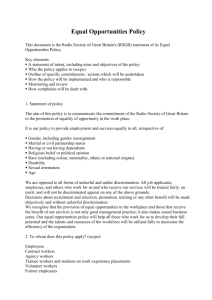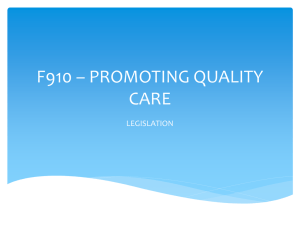paper - Community Legal Centres NSW
advertisement

New Models in Anti-Discrimination Law – developing strategies to campaign for change Belinda Smith & Shirley Southgate Workshop paper Wednesday 9 April 2008 New South Wales Community Legal Centres State Conference 7 – 9 April 2008 Introduction In this workshop we intend to: examine the models of anti-discrimination law that we work with in NSW; look at other models of anti-discrimination law as they operate in other jurisdictions; determine what the gaps and limitations are in our current ways of working; and formulate strategies to campaign for law and policy reform, in order to address the shortcomings of the current legislative regime. The purpose of this paper is to provide some background to the workshop and suggest possibilities for reform that we can build on in the workshop. The current system We pose the following questions as a way to review our current anti-discrimination laws and, thereafter, we have set out a response to some of these questions: 1. Does the law need to be changed to improve equality of opportunity and the elimination of discrimination in Australia? 3. Are the current ways of preventing discrimination working well or could they be improved? 4. What role should the HREOC/ADB have in preventing discrimination, including additional powers or functions (if any)? 5. Would any potential conflict of interests arise if the Commission/Board takes on additional powers or functions? If so, how could this conflict best be managed? 6. Could technical aspects of the law (including protected attributes and the definitions of ‘direct’ and ‘indirect’ discrimination) be improved so that the law itself does not prevent the elimination of discrimination? 8. What role should the Commission/Board have in resolving discrimination, including any additional powers or functions (if any)? 9. Are there ways in which disputes can be resolved that allow systemic and public interest issues to be raised? 1 While federal and NSW laws obviously differ in some respects, they are very similar in the framework or regulatory model underpinning the legislation and thus share many limitations, which are briefly outlined below. Approach and outline The government has a wide range of tools it can use to regulate individual and corporate behaviour in order to address issues of public concern such as discrimination and equality. There is a vast and growing body of regulatory scholarship which explores the way in which law can be used to regulate behaviour. Insights of this scholarship have been applied in many fields, such as occupational health and safety, environmental protection, trade practices and taxation. In other jurisdictions, such as the United Kingdom, such insights are also being applied to the issues of discrimination and equality.1 However, to date, there has been very little consideration of how regulatory scholarship could inform the debates and thinking about equality in Australia. In respect of organisational behaviour, to be effective regulation needs to acknowledge and respond to the fact that organisations will vary widely in respect of three key elements: commitment to addressing the problem; skills for addressing the problem; and institutionalisation of self-regulation and problem solving.2 What this means is that effective regulation should prompt organisations to identify or acknowledge a problem and commit to addressing it, prompt and enable the development and application of necessary skills for addressing the problem, and institutionalize selfregulation and development in respect of the objectives.3 While our anti-discrimination laws have some capacity to prompt an organisational response to the problem of discrimination and equality, they are very poor at equipping organisations with the information and skills required to address the problem or effectively self-regulate, and provide virtually no capacity to monitor or evaluate such organizational responses.4 Sandra Fredman has identified that: ‘Two different models are emerging for the achievement of gender equality: an individual complaints led model based on a traditional view of human rights; and a proactive model, aiming at institutional change.’5 Anti-discrimination laws across Australia are substantially similar in terms of See Christopher McCrudden, ‘Equality Legislation and Reflexive Regulation: A Response to the Discrimination Law Review’s Consultative Paper’ (2007) 36(3) Industrial Law Journal 255; and Bob Hepple, Mary Coussey and Tufyal Choudhury, Equality: A New Framework – Report of the Independent Review of the Enforcement of UK Anti-Discrimination Legislation (2000). 2 Christine Parker, The Open Corporation: effective self-regulation and Democracy (2002) CUP. 3 Ibid. 4 Belinda Smith, "A Regulatory Analysis of the Sex Discrimination Act 1984 (Cth): Can it effect equality or only redress harm?" in C Arup, et al (eds), Labour Law and Labour Market Regulation - Essays on the Construction, Constitution and Regulation of Labour Markets and Work Relationships, Federation Press: Sydney (2006); Belinda Smith, “Not the Baby and the Bathwater – Regulatory Reform for Equality Laws to Address Work-Family Conflict”, (2006) 28(4) Sydney Law Review 689. 5 Sandra Fredman, ‘Changing the norm: positive duties in equal treatment legislation’ (2005) 12 Maastricht Journal of European and Comparative Law 369, 369. 1 2 their regulatory framework and they clearly reflect the first model described by Fredman relying upon change to be brought about by individual victims pursuing private rights against individual perpetrators of discrimination. We set out below (a) limitations and recommendations in respect of the existing rights based model of anti-discrimination laws in Australia, and (b) ideas or options in respect of developing additional mechanisms to better promote systemic and institutional change. (a) Rights based model In designing legal responses to human problems, there are various options open to the legislature and implications in making particular choices. One way to understand how a law is designed to address a problem is to break it down into four aspects – the rule, enforcer, process and sanction (see appendix table). To modify human behaviour the law must establish a standard or rule and there are various ways in which this can be done. It must specify who gets to complain about or prosecute someone if there is a breach of the rule. There must be a process for establishing whether or not there has been a breach and, ultimately, the sanction for violating the rule must be specified. Applying this framework to anti-discrimination laws helps to illuminate some of the limitations (and strengths) of these laws in achieving the goal of equality. Limitations Belinda has explored extensively why the existing individual rights based model adopted in Australian anti-discrimination laws is limited in its effectiveness.6 While antidiscrimination laws have the potential to promote equality, mostly they are designed to resolve complaints of discrimination as individual, interpersonal disputes. There are features of the Australian model of anti-discrimination laws that severely limit the effectiveness of these laws in achieving the broader goal of equality, understood as security, dignity and social inclusion. The key limitations are: The Rule - the standard of behaviour established in our anti-discrimination laws is only a negative one, a proscription of discriminatory behaviour. This means that organisations are required to ‘not discriminate’, but are not required to do anything in order to promote equality. The trigger for organisational response is the finding of fault for breach of the proscription, and this finding is dependent upon an individual victim having a sufficient understanding of discrimination laws, and sufficient interest, resources and capacity to pursue litigation for redress. Fortunately, despite the low litigation risk posed by this system, the normative power of the prohibition and the business case for eliminating discrimination operate to prompt some self-regulation by organisations. Further, the distinction between direct and indirect discrimination is difficult to comprehend and apply,7 and, with the victim required to prove all elements, the burden of proof is too onerous. Smith ‘A Regulatory Analysis’ and Smith ‘Not the baby and the bathwater’, above n 4; Belinda Smith, ‘It’s About Time – for a new approach to Equality’ (2008) Federal Law Review (forthcoming). 6 Belinda Smith, ‘From Wardley to Purvis – How Far Has Australian Anti-Discrimination Law Come in 30 Years?’ (2008) 21 Australian Journal of Labour Law (forthcoming). 7 3 Enforcement - the right to prosecute for breaches is limited to victims. ‘Establishing a prohibition that relies for enforcement on initiatives taken by disempowered victims, rather than proactive enforcement by a public agency, is arguably one of the weakest forms of achieving behavioural change, barely one step above free-market self-regulation.’8 Looking around the world to other jurisdictions (eg UK, Canada, South Africa) it is clear that the Australian approach of not establishing agency advocacy and enforcement is unusual. It is worth noting that the regulation of discrimination is also unusual in this regard in comparison within Australia to the regulation of other problems such as occupational health and safety (which is public prosecution), working conditions established under the Workplace Relations Act (which allows for public, victim and third party enforcement) and anti-competitive practices and consumer rights. It is arguable that this is one of the key weaknesses in the Australian regulatory model for equality and must go some way to explaining why our laws have not been more effective at promoting equality. The absence of an enforcement agency also limits the capacity of the state to regulate ‘responsively’.9 Sanction - the sanctions are largely only compensatory, with limited scope for aggravated damages, no exemplary or punitive components, and, more importantly, no capacity to make corrective or preventative orders that extend beyond the individual victim (other than a limited power in NSW10). ‘This has a number of implications. Firstly, it serves to reinforce the characterisation that discrimination is merely an interpersonal dispute in which only the complainant is harmed, not colleagues, family or the wider society. Further, in a victim-driven compensatory system, discrimination that is systemic is likely to go unaddressed because no individual victim has been so specifically harmed as to prompt litigation. Finally, by focussing only on redressing harm done to the victim, Australian anti-discrimination laws do not require or even necessarily prompt structural and preventative change. Even if an employer is found to have discriminated, they will only be ordered to compensate the victim. The courts lack power to order systemic corrective orders, such as a change in policy, the introduction of a compliance program that might prevent further discrimination, an audit to ascertain further or more widespread incidence of discrimination similar to that of the individual complainant, or to set reform standards. In this way, the laws are more focussed on redressing harm, not preventing harm or promoting equality.’11 The absence of a hierarchy of sanctions further limits the capacity of the state to regulate responsively. Process - the dispute resolution process prior to hearing is an informal one that mostly keeps breaches out of public view, thus limiting the publicity threat of actions and the useful public elaboration of the general legislative prohibition. While on Smith, (2006) "A Regulatory Analysis” above n 6 at 115. Iain Ayres and John Braithwaite, Responsive Regulation: Transcending the Deregulation Debate, (Oxford University Press, New York, 1992). 10 Anti-Discrimination Act 1977 (NSW) s.108(2) (a) & (3) 11 Smith ‘It’s about time’ above n 6. 8 9 4 occasion the private or confidential nature of the conciliation process is a useful carrot to prompt a settlement for the individual complainant, it does mitigate against the sort of systemic change that a public process of investigation might engender. The regulatory model of Australian anti-discrimination law is a fault based, individual rights model which is not adequately equipped to achieve its goals of eliminating discrimination and promoting equality. It is outdated and could be developed to better reflect regulatory insights that have been applied to a vast array of other fields. These laws may work to resolve disputes over discrimination and promote formal equality – raising awareness and encouraging decision-making based upon merit rather than assumptions and stereotyping – but the model offers little to ensure systemic discrimination is addressed and substantive equality achieved. The victims of discrimination may be well placed to see the disadvantage but not sufficiently wellresourced to be the drivers of change through litigation. Organisations who are committed to doing the right thing, are provided with insufficient guidance on compliance (due to the lack of legal codes or jurisprudence). Finally, a system that only requires employer action if wrong-doing is found frames individual discriminatory acts as interpersonal disputes, rather than looking at inequality as a public problem that harms us all. Options for reform? 1. Amend the definition of discrimination – the Canadian model could be reviewed to consider the abolition of a distinction between direct and indirect discrimination. This would involve a consequential shift in focus away from treatment versus impact, to whether the distinction or requirement is reasonable. This would also help to resolve the limitations on direct discrimination actions established by the High Court’s case of Purvis v New South Wales (Dept of Education and Training) (2003) 217 CLR 92. Further, given the difficulties of proving direct and indirect discrimination, the burden in respect of detriment or causation (direct discrimination) and reasonableness (indirect discrimination) should be shifted to the respondent. This is particularly important if the current system is to be retained of only providing victim prosecution, without agency advocacy. 2. Expand the grounds of prohibited discrimination: The definition of a prohibited ground of discrimination could be extended beyond the existing listed grounds, as it has been in South Africa, to include any other ground where discrimination based on that other ground causes or perpetuates systemic disadvantage; undermines human dignity; or adversely affects the equal enjoyment of a person’s rights or freedoms in a serious manner comparable to discrimination on one of the listed grounds.12 3. Codes of practice. The Commission or Board should be empowered to develop statutory codes to provide compliance guidance, akin to those provided for in the UK. Currently the only formal mechanism provided for elaborating on the general prohibition on discrimination and harassment is through court decisions. With so few court decisions, there is little and poor guidance offered to those who seek to improve compliance with the legislation. Codes are resource intensive to produce but the 12 Promotion of Equality and Prevention of Discrimination Act 2000 (Republic of South Africa), s.1(xxii) 5 process of consultation in their production and the value of the outcome in developing a public understanding of discrimination and equality need to be factored into the cost equation. Like the Sexual Harassment Code of Practice (which is an informational guide rather than a mandatory or evidentiary statutory code), codes can be updated as more sophisticated understandings of equality and best practices develop. 4. Provide for public advocacy and enforcement of discrimination breaches Expand the Commission’s/Board’s, or preferably a separate body’s, power to further support complainants or even initiate inquiries into indirect and systemic discrimination in order to more proactively promote equality rather than rely upon reaction driven by disempowered victims. 5. Expand the range of sanctions to better address systemic and repeat discrimination – The array of sanctions available for breach should be expanded to include corrective or preventative orders for indirect and systemic discrimination (as in NSW) and punitive damages or public penalties (for repeat offenders or particularly egregious and intentional acts of prejudice). 6. Publication of decisions and thorough and accurate collection of data – to allow proper monitoring and analysis of the laws and their impact and effectiveness. (b) Proactive model The above recommendations are designed to improve the effectiveness of an individual rights based model, drawing on regulatory insights that have been applied to this field in other jurisdictions and other fields in this jurisdiction. However, jurisdictions such as the UK have gone further than simply amending the rights based systems. The UK has added positive duties to the regulatory armory for addressing inequality, thereby altering the model to make it more proactive and designed to bring about institutional change. Sandra Fredman contrasts the positive duties approach to the complaints based model: At the root of the positive duty … is a recognition that societal discrimination extends well beyond individual acts of racist prejudice. Equality can only be meaningfully advanced if practices and structures are altered proactively by those in a position to bring about real change, regardless of fault or original responsibility. Positive duties are therefore proactive rather than reactive, aiming to introduce equality measures rather than to respond to complaints by individual victim. This has important implications for both the content of the duty and the identification of the duty bearer. In order to trigger the duty, there is no need to prove individual prejudice, or to link disparate impact to an unjustifiable practice or condition. Instead, it is sufficient to show a pattern of under-representation or other evidence of structural discrimination. Correspondingly, the duty-bearer is identified as the body in the best position to perform this duty. Even though not responsible for creating the problem in the first place, such duty bearers become responsible for participating in its eradication. A key aspect of positive duties, therefore, is that they harness the energies of employers and public bodies. Nor is the duty limited to providing compensation for an individual victim. Instead, positive action is 6 required to achieve change, whether by encouragement, accommodation, or structural change.13 The race duty was the first to be introduced, but positive duties in respect of gender and disability operate in a similar way. The Gender Equality Duty has been described as: [T]he biggest change in sex equality legislation in thirty years, since the introduction of the Sex Discrimination Act itself. It has been introduced in recognition of the need for a radical new approach to equality – one which places more responsibility with service providers to think strategically about gender equality, rather than leaving it to individuals to challenge poor practice.14 The general duties imposed under these new laws are supplemented by specific duties imposed on particular public authorities. Specific duties in respect of gender equality require each authority to: Prepare and publish a gender equality scheme, showing how it will meet its general and specific duties and setting out its gender equality objectives. In formulating its overall objectives, consider the need to include objectives to address the causes of any gender pay gap. Gather and use information on how the public authority's policies and practices affect gender equality in the workforce and in the delivery of services. Consult stakeholders (i.e. employees, service users and others, including trade unions) and take account of relevant information in order to determine its gender equality objectives. Assess the impact of its current and proposed policies and practices on gender equality. Implement the actions set out in its scheme within three years, unless it is unreasonable or impracticable to do so. Report against the scheme every year and review the scheme at least every 3 years. 15 These duties go further than the federal affirmative action duty under the Equal Opportunity for Women in the Workplace Act 1999 (Cth) in that they apply in respect of race, disability and gender in respect of all functions of all public authorities, including policy making, the provision of services, and employment. Importantly, the specific duties require public disclosure of audits and equality schemes, something which EOWWA does not. In Victoria, the new Charter imposes duties on the public service, but the UK duties go further in a number of ways: there are both general duties and more specific, detailed process duties, compliance guidance is provided through statutory codes of practice developed in respect of each of the three duties; and 13 Sandra Fredman ‘Equality: a new generation?’ (2001) 30(145) Industrial Law Journal 12-13. 14 Code of Practice, Foreword Equal Opportunity Commission, http://www.eoc.org.uk/. 15 CEHR, Gender Equality Duty, Specific Duties http://www.equalityhumanrights.com/en/forbusinessesandorganisation/publicauthorities/Gender_equality_duty/Pages/ Variationsbycountry.aspx 7 the Equality and Human Rights Commission is given the capacity to enforce the duties, regulating responsively, through audits, compliance notices and ultimately court orders. The Discrimination Law Review currently being undertaken in the UK has put forward a consultation paper in which it proposes retention of the public authority duties.16 However, it also puts forward a number of reform options in respect of these duties, which should be considered for application in Australia. The recommendations include: integration of the duties in respect of each ground into a single duty; extension of the duties to cover other grounds; requiring public authorities to identify priority equality objectives and take proportionate action toward their achievement; requiring such proportionate action using four principles of consultation and involvement, use of evidence, transparency, and capability.17 16 Department of Communities and Local Government, Discrimination Law Review, A Framework for Fairness: Proposals for a Single Equality Bill for Great Britain: A consultation paper (June 2007), available at: http://www.communities.gov.uk/publications/communities/frameworkforfairnessconsultation 17 Id at 82-82 8 Outline of Regulatory Options and Choices for Australian Anti-Discrimination Laws Rule/Standard Enforcer – who takes action? Process for resolving dispute Negative – prohibition (eg you must not discriminate…) Public prosecutor (eg Director of Public Prosecutions, or a specialist agency as for trade practices (ACCC)) Public hearing in court or Public sanctions: tribunal – adversarial? Fine – nominal or penalties – paid to Usual procedure? government Private alternative Gaol? dispute resolution, left to design and means of the Community service? parties? Corrective/preventative – change policy, address imbalance, establish training Publicly provided procedures, etc – to prevent further private/confidential discrimination/ harassment conciliation or mediation Positive duty (eg you must promote equality by identifying barriers, developing an affirmative action Victims – individual victim policy, implementing to bring claim on their own programs…) behalf Substantive – must achieve proportional representation Combination of these? Process – must develop policy and revise recruitment procedure… General – leaving discrimination and harassment mostly undefined Third parties eg unions, advocacy groups, etc Combination of these Specific – giving detail about what constitutes discrimination or harassment Role for agency? Role for agency? Role for agency? 9 Sanction/remedy Private sanctions: Damages – compensatory, punitive – paid to victim Injunctive – stop behaviour, reinstate victim Corrective/preventative – change policy, revise recruitment or assessment procedures – not only for victim Role for agency? Planning a campaign for change Clearly, it is our argument that the current anti-discrimination systems that apply in NSW need to be reformed to be effective in working towards eliminating discrimination. The following table contains some initial suggestions of changes and actions required to achieve these changes. It is a starting point for discussion only. We hope to discuss, amend and add to this during the workshop, to develop a law reform campaign for CCLCG. Overall goal: To have a new, more effective legislative and policy framework to promote substantive equality and eliminate discrimination. OBJECTIVES Prompt public discussion and debate about antidiscrimination law and policy STRATEGIES Develop a legislative outline/framework that can be used by parliamentary drafters for new legislation Engage discrimination practitioners and other interested people in discussions about reforms ACTIONS Review alternative models in use in other fields and jurisdictions; Develop a model that will be applicable in NSW List and contact people who might be interested: Representative and advocacy groups (eg PWD; MRC’s: YWCA); lawyers; academics; unions; ADB; HREOC Invite comment/response to the reforms proposed within a definite time frame; Publicity/media coverage – articles/interviews/discussion papers 10 WHO WHEN Get the issue of discrimination law reform onto the political agenda Engage relevant ministers and other politicians Develop a lobbying kit; Meet with relevant politicians – ask for definite responses and actions (questions in parliament etc) 11









